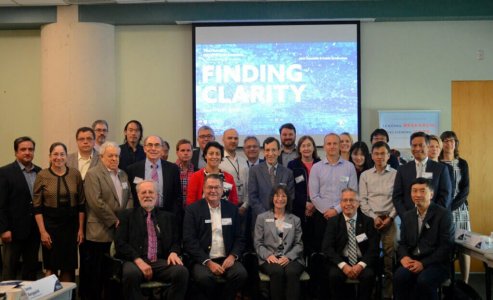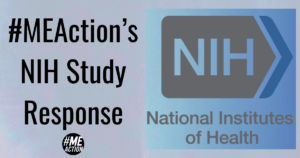By Christopher Armstrong, PhD, OMF Science Liaison
When the Harvard ME/CFS Collaborative at Harvard Affiliated Hospitals was initiated last year with funds from Open Medicine Foundation (OMF), it was considered a commitment to co-leaders, Ronald G. Tompkins, MD, ScD, and Wenzhong Xiao, PhD, to begin a research operation in one of the world’s most respected academic institutions. The Harvard Collaboration works in coordination with the other OMF-funded ME/CFS Collaborative Research Centers at Stanford University, under the direction of Ronald W. Davis, PhD, and at Uppsala University, under the direction of Jonas Bergquist, MD, PhD.
Beyond their depth of experience in metabolism and inflammation, Drs. Tompkins and Xiao together have shown the ability to lead multi-center $100 million-plus collaborative projects, compile complex datasets, and improve disease outcomes based on their data interpretation. These are skills that will be essential for building a collaboration with the extremely talented pool of researchers and clinicians that Harvard and its affiliated hospitals have to offer.
“Finding Clarity” was the title for the inaugural Harvard ME/CFS collaboration symposium funded by OMF, a reference to the complexity of ME/CFS but also the refining of a vision for what this Harvard collaboration is capable of building.
The public symposium began with Dr. Tompkins highlighting the extraordinary team at Harvard who are either already researching ME/CFS or intend to begin. Most striking is the number of MDs involved, largely because the institutes involved are Harvard affiliated hospitals, including Massachusetts General Hospital, Brigham and Women’s Hospital, and Beth Israel-Deaconess Medical Center.
Three of the MDs are physicians with a great deal of experience in treating ME/CFS patients: Dr. Donna Felsenstein, Dr. Amel Karaa, and Dr. Anthony Komaroff. For effective research, it’s critical to have experienced physicians evaluate and diagnose ME/CFS patients prior to their inclusion into studies. Collectively, these physicians conducted a round-table discussion at the symposium where they highlighted their individual expertise and what they could contribute to ongoing and future research projects. Their openness about their professional experience with ME/CFS and willingness to field questions from the audience was particularly noteworthy.
The fact that clinicians and scientists are working closely together is a significant strength of the Harvard ME/CFS collaboration, as it enables the monitoring and measurement of biochemical and physiological variables in ME/CFS patients under a variety of conditions over time, such as before, during and after exercise. The vision Dr. Tompkins has for this collaborative research is to collect a multitude of data that reflects the biological process occurring in ME/CFS patients over time. Such measurements will provide much more clarity into the underlying process of the disease. Examples of these measures include multiple samples of blood, urine and muscle tissue for multi-omics analysis, advanced brain imaging, gas exchange, and heart monitoring. This type of experimentation requires extensive planning to simultaneously obtain many measurements from each patient successfully. Every effort is made to collect as many sample types and measurements at each time point as possible to minimize missed opportunities for data collection.
One current study of particular interest has been initiated by Dr. David Systrom. He was unable to present at the symposium, but Dr. Tompkins was able to describe the key features of this work. Dr. Systrom has conducted invasive Cardiopulmonary Exercise Tests (iCPET) on ME/CFS patients and determined a preload failure (PLF) pattern. PLF is the failure of the heart to increase filling pressure and stroke volume during exercise. The reason for PLF in ME/CFS patients requires a deep-dive characterization using multi-omics analysis of blood samples taken before, during, and after the iCPET. Multi-omics broadly means the analysis of all the tiny molecules within the biofluid or tissue that have been sampled; these molecules are the basis of life and loosely include metabolites (glucose, amino acids, fatty acids, etc.), cell proteins, and genetic material.
Not only can samples from this iCPET study be used for further characterization of PLF but they will also be used to characterize the systemic biological changes in ME/CFS patients before, during, and after exercise. The multi-omics data extraction from these samples will be conducted by collaborators at the Pacific Northwest National Laboratory, and analysis and interpretation of these data matrices will be a group effort led largely by Dr. Xiao.
In conjunction with the iCPET study conducted by Dr. Systrom, a collaboration has already been set up with Dr. Michael VanElzakker in which brain images were taken before and after exercise. Dr. VanElzakker spoke at the symposium, where he proposed that inflammation in the brain may be a significant part of ME/CFS, and he showed research results to that effect. He briefly described his vagus nerve theory, which suggests that the trigger for this brain inflammation may begin in the periphery near the vagus nerve, which in turn may transmit triggers of inflammation to the brain and brainstem. Dr. VanElzakker revealed results from brain imaging he conducted in collaboration with Dr. Systrom, before and after exercise. Most notably, there was a decrease in blood perfusion in the brain after exercise.
Lending their support to the Harvard ME/CFS collaborative were talks by Dr. Ron Davis and Dr. Maureen Hanson. Dr. Davis is the director of the OMF Scientific Advisory Board and the director of the OMF-funded ME/CFS Collaborative Research Center at Stanford, while Dr. Hanson is a member of the OMF Scientific Advisory board and the director of the Center for Enervating Neuroimmune Disease at Cornell.
Dr. Davis highlighted the extensive list of studies they are working on at Stanford, beginning with the big data study of severely ill ME/CFS patients and the deep search for known and new viral, fungal and bacterial pathogens that may be ongoing contributors to the disease. Central to the research philosophy at Stanford is the development of technology, Dr. Davis showcased two potential diagnostic tools in development, the nanoneedle and the RBC deformability chip. The nanoneedle is further ahead in development at this stage and has successfully separated 100% of ME/CFS patients from healthy controls to date. Both technologies appear promising not just diagnostically but by highlighting important cellular functionality issues in ME/CFS patients and by enabling the testing of potential treatments that restore healthy cellular function.
Dr. Hanson is overseeing several simultaneous research avenues but focused on her group’s research into immunological abnormalities in ME/CFS patients. Dr. Hanson observed the energy pathways in two populations of immune cells, both showed a decreased ability to make energy through glycolysis. Dr. Hanson is also evaluating the messages that immune cells send to each other to communicate, these are extracellular vesicles and their contents may provide a biomarker for the immune abnormalities observed in ME/CFS.
The main fields of research in ME/CFS across the world appear to be a combination of metabolism, immunology, inflammation, brain inflammation, circulatory system, and autonomic dysfunction. Each of these fields are being examined through our established Collaborative Research Centers by world-renowned experts.
The stage is set for a magnificent and intricate research study to incorporate this talent and deeply characterize ME/CFS from the clinical to the molecule.
A recording of all the speakers at the public symposium on June 8 will be made available on OMF’s YouTube channel in the coming weeks.






